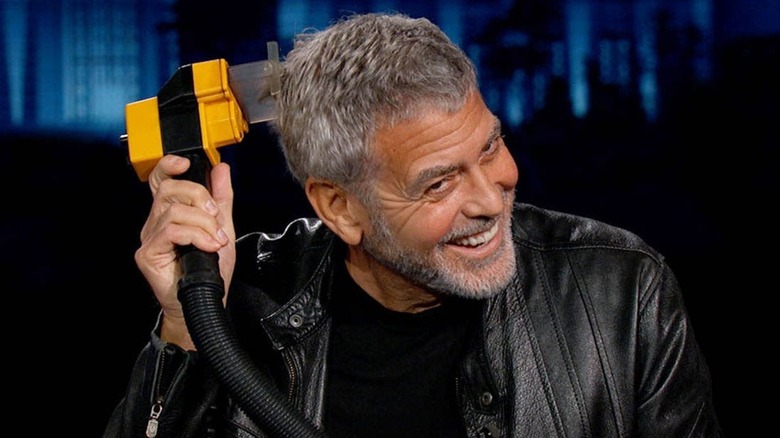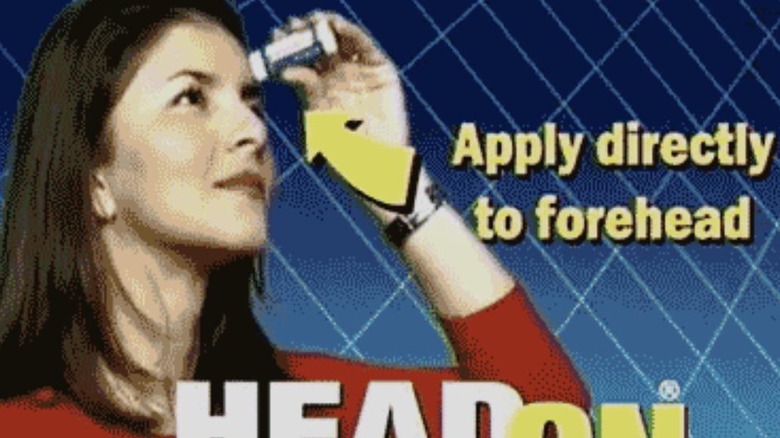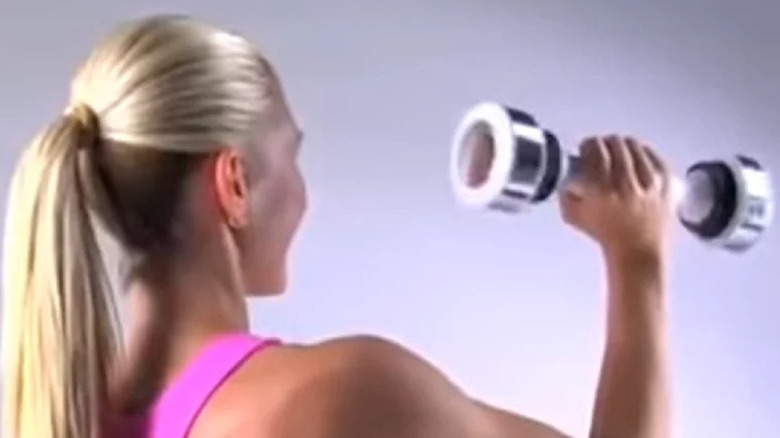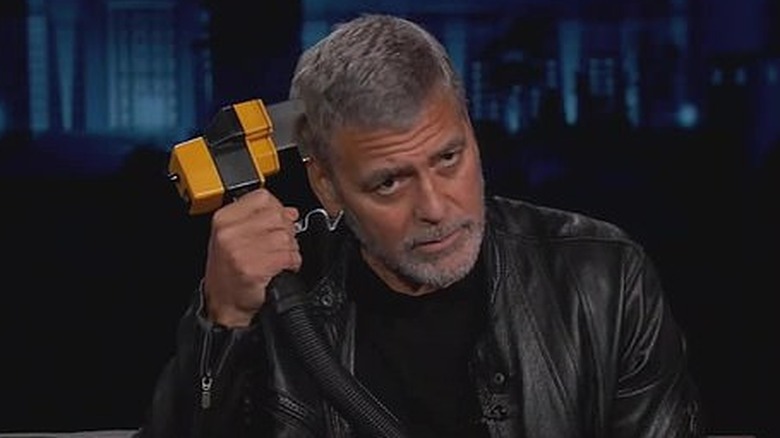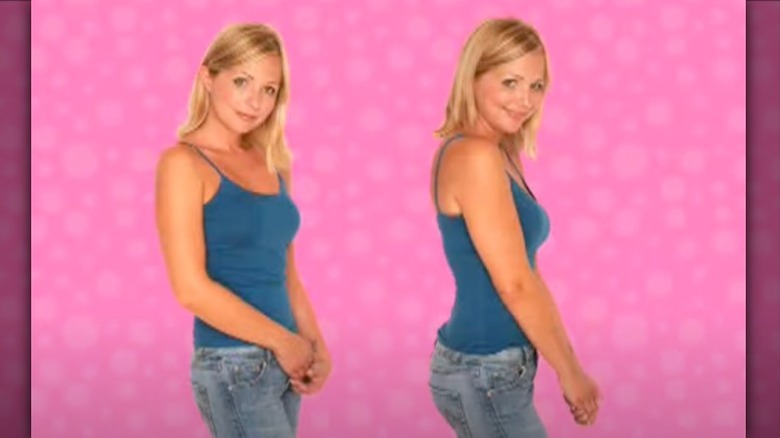As Seen On TV: The 5 Worst Infomercial Products You Never Bought
Imagine this: you're a raging insomniac, and you're awake in the middle of the night in an era before streaming. You don't have thousands of television shows and movies at your fingertips. You have basic cable. And what does basic cable air in the middle of said night? Infomercials. A whole lot of infomercials.
Younger readers might not be as familiar with the long-form commercial format where peppy hosts re-enact (seemingly made-up) problems that can only be solved by their hyper-specific and often bizarre products, but for a long time, infomercials were a pretty huge medium. (QVC, the home-shopping network, is basically one giant infomercial at all times.) With all of those infomercials came a laundry list of dubious products — never forget that the "Snuggie," a blanket with holes for your arms, is an infomercial product. So what are the absolute dumbest ones that you (hopefully) never purchased? From fraudulent workout quipment to a headache cure that might end up causing you pain in the first place, here are five of the worst and silliest choices.
HeadOn
Per the HeadOn infomercial, there's literally one thing you need to know about this product: "HeadOn! Apply directly to the forehead!" (In case you're not sure where your forehead is, there's also an arrow pointing directly to the model's own forehead.) This particular infomercial, which just utilizies that single sentence over and over again, wasn't limited to the wee hours of the morning. In 2006, the commercial was just everywhere and aired during both odd and "normal" hours, irritating everyone in the process; it honestly feels like they made the ad as grating as possible to give you a headache that you would then have to cure with the headache-curing stick said to be a homeopathic method.
The HeadOn commercial is notable for the utter lack of information about what the product is, the fact that it's recorded at a volume that feels entirely too loud for no reason, and also just its overall absurdity; it's no wonder that this product was spoofed by outlets like The Daily Show at the time. If the HeadOn commercial gave you a headache, here's hoping you popped a few ibuprofen or something similar instead of rubbing what looks like a glue stick "directly to the forehead."
Shake Weight
Look. Everybody knows about the Shake Weight. It's been parodied absolutely everywhere, from "South Park" to "Saturday Night Live" to "Thor: Love and Thunder." Basically, it's a dumbbell that you shake up and down in a manner that can only be described as ... suggestive. To sell prospective fitness enthusiasts on the equipment, the commercial shows people pulling at their arms, dissastisfied with their lack of tone, until their lives finally change thanks to the Shake Weight.
According to a 2013 article in Business Insider, who pulled from a study conducted by the Journal of Sports Science & Medicine, it doesn't actually work, though. "Researchers found [...] that the 25 young adults they tested displayed no more muscle activity than they did using regular dumbbells," the study concluded. "What's more, the study found that people who did the shaking exercise routines prescribed by Shake Weights did not do enough work to increase muscle strength." This particular infomercial scam item did sell pretty well, though — so hopefully, you don't have a Shake Weight collecting dust, unshaken, at the back of your closet.
Flowbee
Apparently, back in the late 1980s, consumers didn't feel like they had enough options for at-home haircuts. Enter the Flowbee, which, according to the product's official website — because it still exists! — is "the best vacuum haircutting system in the market." (One has to wonder how much competition there really is, but we digress.) Whether people used a dedicated Flowbee Mini Vac or just hooked the damn thing up to their own vacuums, the equipment would then allow someone to cut their hair using a piece of equipment called a "cutting head." The result looks absolutely bonkers, as you can see in the original ad from the late '80s.
Flowbees are one of the most famous examples of a "silly infomercial product," but in 2020, a major Hollywood superstar revealed he's been cutting his own hair with this dubious machine for decades. In late 2020, George Clooney told CBS Sunday Morning that he's been using a Flowbee on his own hair for over twenty years. "Years ago, I bought a thing called a Flowbee," Clooney revealed. "It comes with a vacuum cleaner and the clippers? Yeah, I still have it! My haircuts take literally two minutes." After confirming that his haircut is, in fact, a "Flowbee special, Clooney continued, "Yeah, that's Flowbee! Listen, man, it works. Now, you know ... I wouldn't do it to my wife." Clooney also said his haircuts with the device take "two minutes," so if it works for him, then that's great. You might not get the same result as an A-list movie star, though.
Booty Pop
Ever tried on a pair of jeans and just felt like something was ... missing? If so, you apparently want to buy a Booty Pop, a piece of padding that gives a little lift and "oomph" to your backside. (At least, you could; as of this writing, all of the options on major retailers like Amazon are listed as "currently unavailable" and the official Booty Pop website leads to a dead end.)
Anyway, it feels like there are a lot of options you could try if you have this made-up "problem" instead of the seemingly defunct Booty Pop — which is basically just one of those stupid hair "Bump It" hair insert for your derriere. You could get jeans that fit better. You could do squats. You could stop obsessing over whether your booty pops, if you happen to be fixating on that. Don't buy a Booty Pop. Once again, it doesn't seem like you can anymore — which is for the best.
GLH Canned Hair
Balding happens, and if you're affected by it, you might seek out any number of options to hide signs of thinning hair. You know what you shouldn't seek out? Spray-on hair.
Though it seems like a product that can only be described as "canned hair" might be out of vogue these days, you'd be mistaken; in 2018, Vox ran an article about spray-on hair products after Stephen Miller, then an adviser to former President Donald Trump, seemed to be donning it at a press conference. The outlet specifically names the biggest brand from the 1990s, which itself was the subject of plenty of infomercials: "'Spray-on hair' is a misnomer because the modern iteration is not technically a spray at all — the most commonly used hair fill-in product today is fiber powder that you sprinkle on your head to thicken existing hair and add more density. But this temporary hair loss solution (used by makeup artists and regular consumers alike!) is still called spray-on hair colloquially thanks to a brand called GLH, which is short for Good Looking Hair."
Whether or not this product works years after GLH hit the market is immaterial; the point is that GLH, the brand that advertised via infomercials, was an early iteration of the product that definitely seems lacking (and, frankly, gross to apply). It seems fair, though, to presume that "spray-on hair," misnomer or not, just shouldn't be an option at all.
